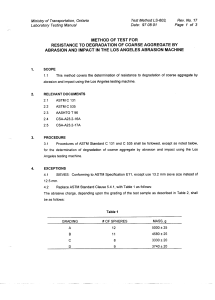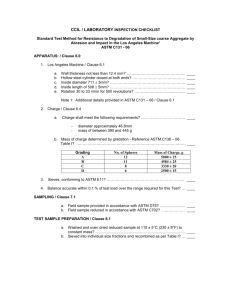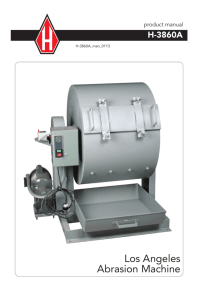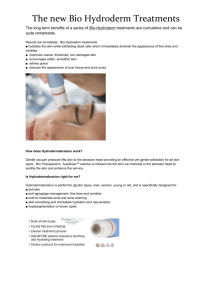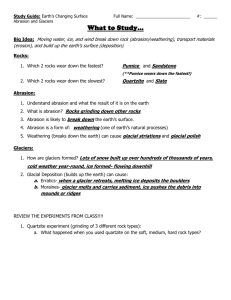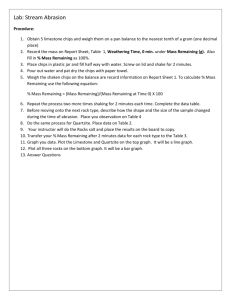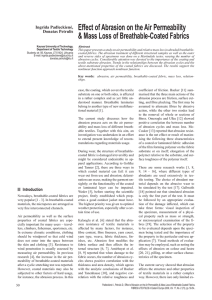abrasion of surfacing aggregates - Nanyang Technological University
advertisement
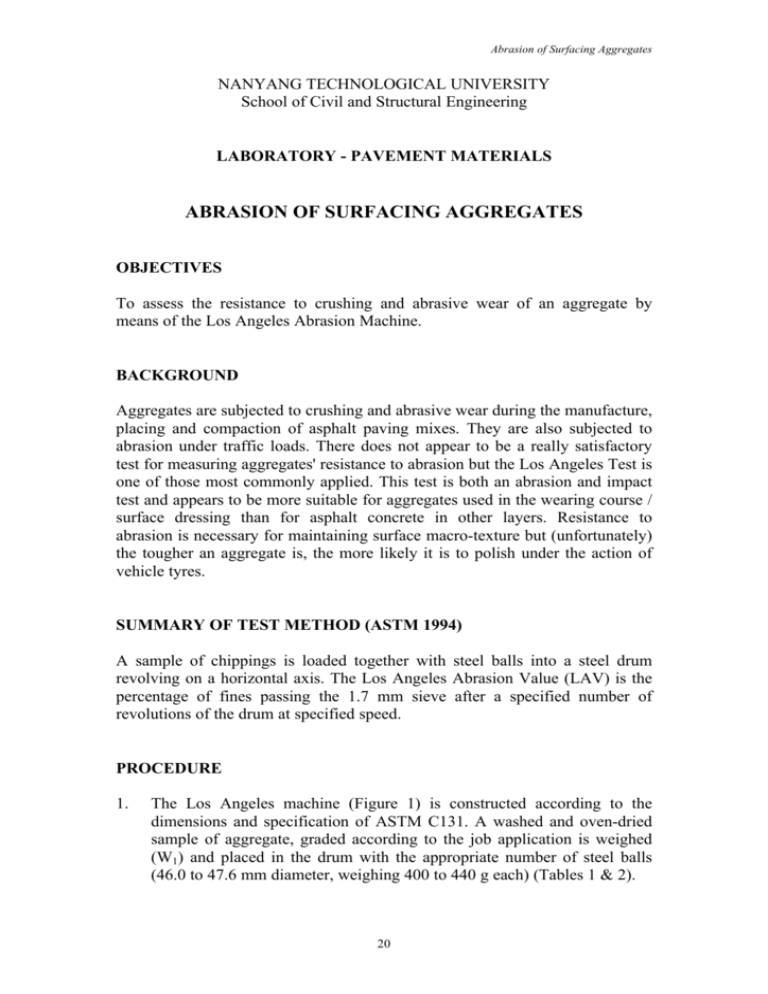
Abrasion of Surfacing Aggregates NANYANG TECHNOLOGICAL UNIVERSITY School of Civil and Structural Engineering LABORATORY - PAVEMENT MATERIALS ABRASION OF SURFACING AGGREGATES OBJECTIVES To assess the resistance to crushing and abrasive wear of an aggregate by means of the Los Angeles Abrasion Machine. BACKGROUND Aggregates are subjected to crushing and abrasive wear during the manufacture, placing and compaction of asphalt paving mixes. They are also subjected to abrasion under traffic loads. There does not appear to be a really satisfactory test for measuring aggregates' resistance to abrasion but the Los Angeles Test is one of those most commonly applied. This test is both an abrasion and impact test and appears to be more suitable for aggregates used in the wearing course / surface dressing than for asphalt concrete in other layers. Resistance to abrasion is necessary for maintaining surface macro-texture but (unfortunately) the tougher an aggregate is, the more likely it is to polish under the action of vehicle tyres. SUMMARY OF TEST METHOD (ASTM 1994) A sample of chippings is loaded together with steel balls into a steel drum revolving on a horizontal axis. The Los Angeles Abrasion Value (LAV) is the percentage of fines passing the 1.7 mm sieve after a specified number of revolutions of the drum at specified speed. PROCEDURE 1. The Los Angeles machine (Figure 1) is constructed according to the dimensions and specification of ASTM C131. A washed and oven-dried sample of aggregate, graded according to the job application is weighed (W1) and placed in the drum with the appropriate number of steel balls (46.0 to 47.6 mm diameter, weighing 400 to 440 g each) (Tables 1 & 2). 20 Abrasion of Surfacing Aggregates Figure 1. Los Angeles Abrasion Machine Table 1. Grading of test samples (ASTM, 1994) Sieve sizes (square openings), mm Passing Retained on 37.5 25.0 25.0 19.0 19.0 12.5 12.5 9.5 9.5 6.3 6.3 4.75 4.75 2.35 Mass of indicated sizes, g Grading (see Table 2 below) B C … … … … … 2500 ± 10 … 2500 ± 10 … 2500 ± 10 … 2500 ± 10 … A 1250 ± 25 1250 ± 25 1250 ± 10 1250 ± 10 … … … 5000 ± 10 Total 5000 ± 10 5000 ± 10 Table 2. Grading and mass of charge Grading Number of balls Mass of charge, g A 12 5000 ± 25 B 11 4584 ± 25 C 8 3330 ± 20 D 6 2500 ± 15 21 D … … … … … … 5000 ± 10 5000 ± 10 Abrasion of Surfacing Aggregates 2. The drum is rotated for 500 revolutions at a speed of 30 to 33 rpm. 3. After this, the sample is separated on a sieve larger than 1.7 mm (say 4.75 mm), then the material passing is washed through a 1.7 mm sieve. If the aggregate is free from dust, the washing requirement may be waived. 4. The material which does not pass the 1.7 mm sieve (and any larger sieve used) is then weighed to the nearest gram (W2). 5. The difference in weight of the sample is expressed as a percentage of the original and is reported as the abrasion value given by LAV = 6. (W1 − W2) x 100 % W1 . . . (1) The results of two tests by the same operator on the same aggregate should not differ from each other by more than 5.7% of their average. For two different operators/laboratories the difference should not be more than 12.7% of the average. DISCUSSION (a) Report the geological description of the aggregate, the source quarry and particle size. (b) Record the original and final weights, and the abrasion value. Comment on any loss in the sample mass in the course of the experiment. (c) Comment on the LAV value obtained with regard to the aggregate’s potential use. [Local requirements are LAV≤35% for wearing course, LAV≤40% for binder course, and LAV≤45% for road base]. (d) Compare your result with those of other groups and comment on the precision of the test results. REFERENCE 1. ASTM (1994). C131-81, Standard test method for resistance to degradation of small size coarse aggregate by abrasion and impact in the Los Angeles Machine. 1994 Annual Books of ASTM Standards, Volume 04.03, American Society for Testing and Materials, Philadelphia, PA 19103-1187. 22
